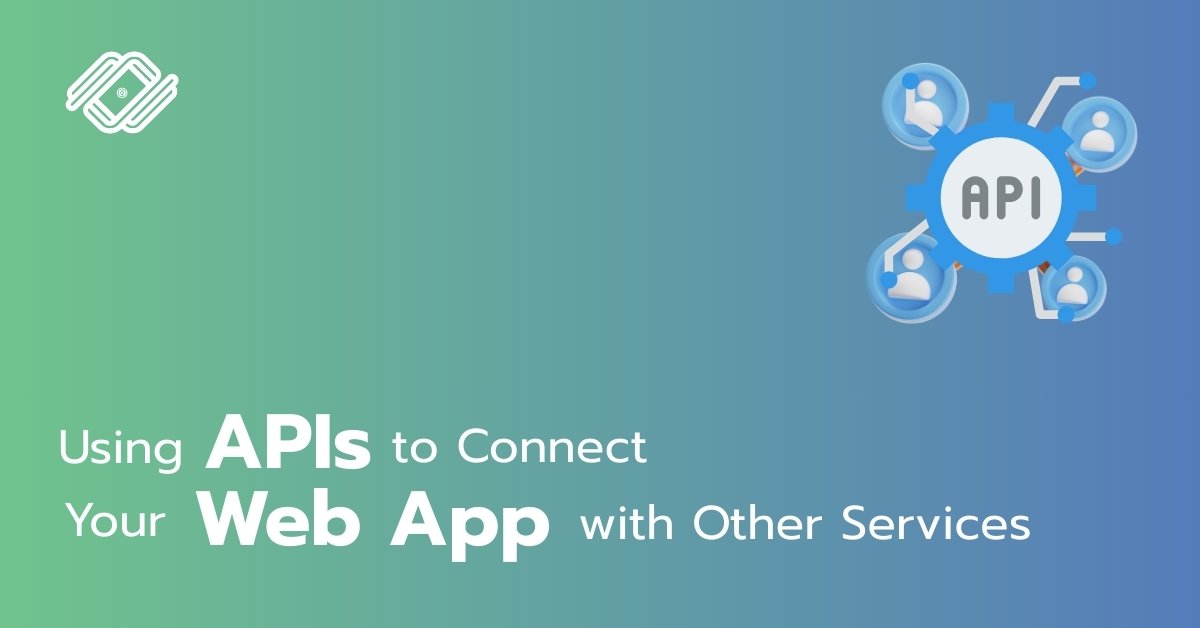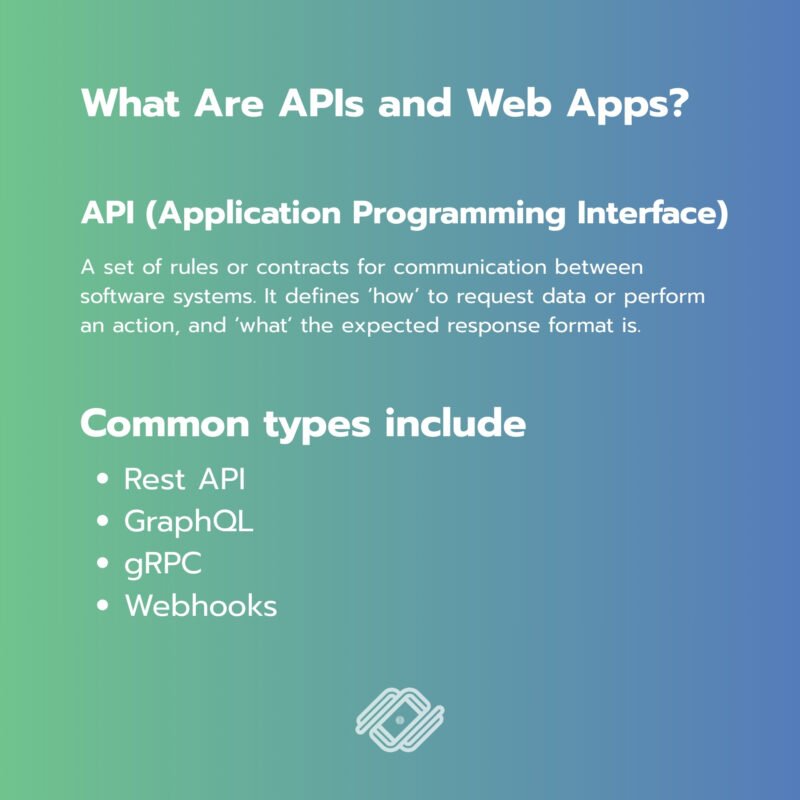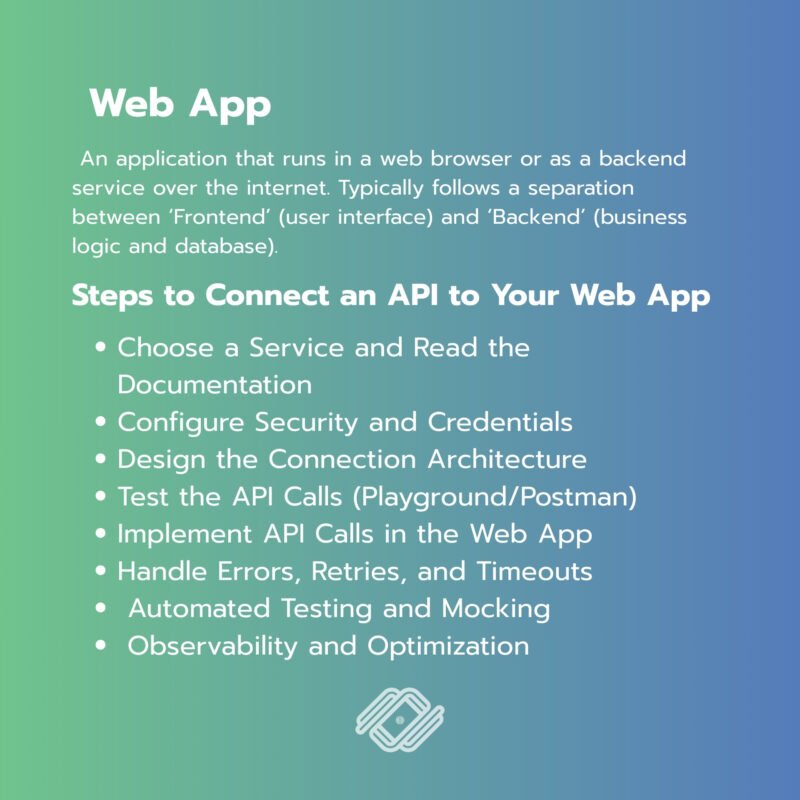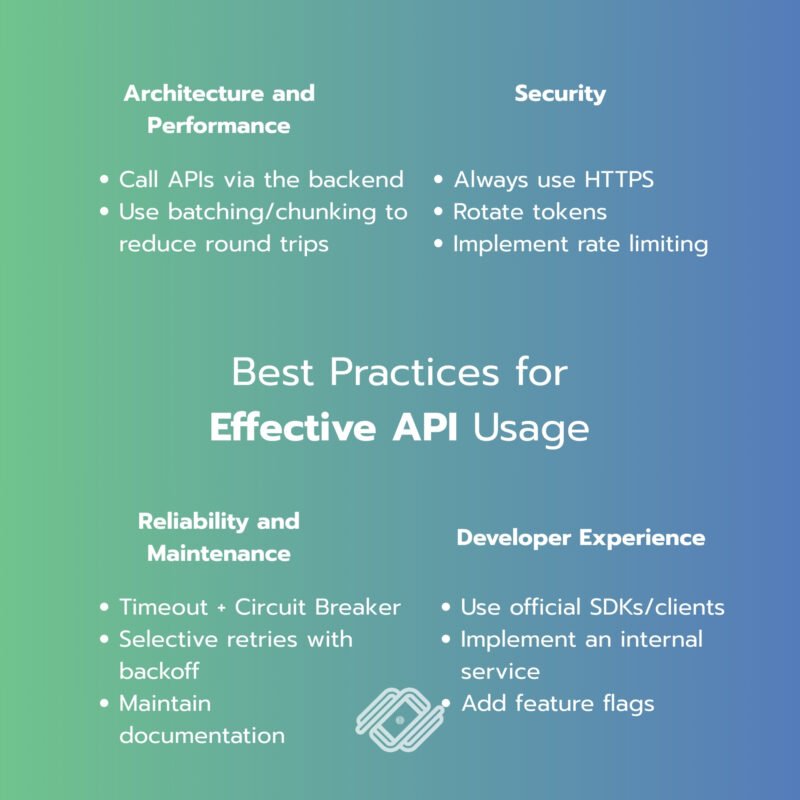
Connecting a Web App to external services—such as payment gateways, map providers, authentication systems, or marketing platforms—is often done through APIs, which allow two systems to “talk” in a standardized, secure, and scalable way. This article explains what APIs and Web Apps are, how to connect them, and best practices for effective API usage.
What Are APIs and Web Apps?

API (Application Programming Interface)
A set of rules or contracts for communication between software systems. It defines ‘how’ to request data or perform an action, and ‘what’ the expected response format is.
Common types include:
- REST API (over HTTP, usually JSON-based)
- GraphQL (flexible querying in a single request)
- gRPC (high performance, uses Protobuf)
- Webhooks (external services “push” notifications to you when events occur)
Web App
An application that runs in a web browser or as a backend service over the internet. Typically follows a separation between ‘Frontend’ (user interface) and ‘Backend’ (business logic and database).
Steps to Connect an API to Your Web App

Step 1: Choose a Service and Read the Documentation
- Identify your business goal (e.g., process payments, send emails, enable SSO)
- Read the API documentation: endpoints, methods, authentication, rate limits, request/response examples, error codes, and usage policies.
Step 2: Configure Security and Credentials
- Register for an API key / Client ID & Secret
- Separate Environments: Development / Staging / Production
- Store secrets in environment variables or a secret manager—never hard-code them in your codebase or expose them in the browser.
Step 3: Design the Connection Architecture
- Decide whether to call the API via the backend (more secure, suitable for keys/secrets) or directly from the frontend (only for public APIs with no secrets).
- Plan the ‘Data Flow’: who calls whom, event order, error handling, retries.
- Define Models/DTOs to map request and response data clearly.
Step 4: Test the API Calls (Playground/Postman)
- Test request/response using Postman, Insomnia, or curl.
- Save working payload examples as test cases.
Step 5: Implement API Calls in the Web App
Step 6: Handle Errors, Retries, and Timeouts
- Set timeouts (e.g., 5–10 seconds)
- Use Exponential Backoff retries for temporary errors (e.g., 429, 503)
- Provide user-friendly error messages and log technical details.
Step 7: Automated Testing and Mocking
- Write unit and integration tests
- Use mock servers to simulate API responses during testing.
Step 8: Observability and Optimization
- Track metrics (latency, error rate, throughput)
- Implement logging, tracing, and alerts
- Review usage regularly to stay within rate limits and budget.
Best Practices for Effective API Usage

- Architecture and Performance
- Call APIs via the backend for security when secrets are involved
- Use batching/chunking to reduce round trips or split large payloads
- Apply caching:
– HTTP-level (Cache-Control, ETag)
– Application-level (Redis, in-memory)
– Appropriate TTLs
- Use pagination and filtering to request only what’s needed
- Ensure idempotency for non-repeatable actions (e.g., order creation) using `Idempotency-Key`
- Use webhooks for event notifications instead of frequent polling
- Security
- Always use HTTPS
- Choose OAuth 0 / OIDC for user authentication or API keys for machine-to-machine calls
- Rotate tokens and apply least privilege (narrowest possible scopes)
- Validate data with schema checks (e.g., JSON Schema, Zod)
- Protect against Injection, XSS, CSRF and keep audit logs for critical actions
- Implement rate limiting/throttling to prevent abuse
- Reliability and Maintenance
- Timeouts + Circuit Breakers to prevent cascading failures
- Selective retries with backoff for temporary errors only
- API versioning to allow changes without breaking clients
- Maintain documentation, sequence diagrams, and verified payload examples
- Monitor costs and API call volume
- Developer Experience (DX)
- Use official SDKs/clients if available
- Implement an internal service layer for clean, maintainable code
- Add feature flags to toggle integrations without redeploying
Production-Readiness Checklist
[ ] Tested all endpoints in the documentation
[ ] Secrets stored securely (env/secret manager)
[ ] Timeouts, retries, circuit breakers, idempotency in place
[ ] Supports pagination, filtering, and caching
[ ] Clear error handling and logging
[ ] Unit/integration tests with mocks
[ ] Monitoring and alerts configured
[ ] Incident response playbook prepared
Example Workflow (End-to-End)
- User clicks “Pay” in the Web App →
- Backend creates an order and calls the payment API with an `Idempotency-Key` →
- User completes payment →
- Payment provider sends a **webhook** to the backend →
- Backend verifies the webhook signature and updates the order status →
- UI displays success message and sends receipt automatically.
Key Takeaways
- APIs are the “common language” for Web Apps to communicate with other services.
- Start with documentation, secure your credentials, design the data flow, test, then integrate.
- Performance and stability depend on caching, pagination, retries/backoff, timeouts, circuit breakers, and idempotency.
- Security first: HTTPS, OAuth/API keys, scoped tokens, validation, and logging.
- Maintain documentation, testing, and monitoring to ensure sustainable growth.
Source: sennalabs.com
If you want your business to reach online customers and achieve sustainable marketing results, we are happy to provide consultation on what you need.
For further inquiries, contact us at:
Tel. 093 696 4498 Line OA: https://lin.ee/po8XduU
E-mail: mongkontep@pkindev.com
Inverze Solutions Co., Ltd. has received numerous awards for its achievements
